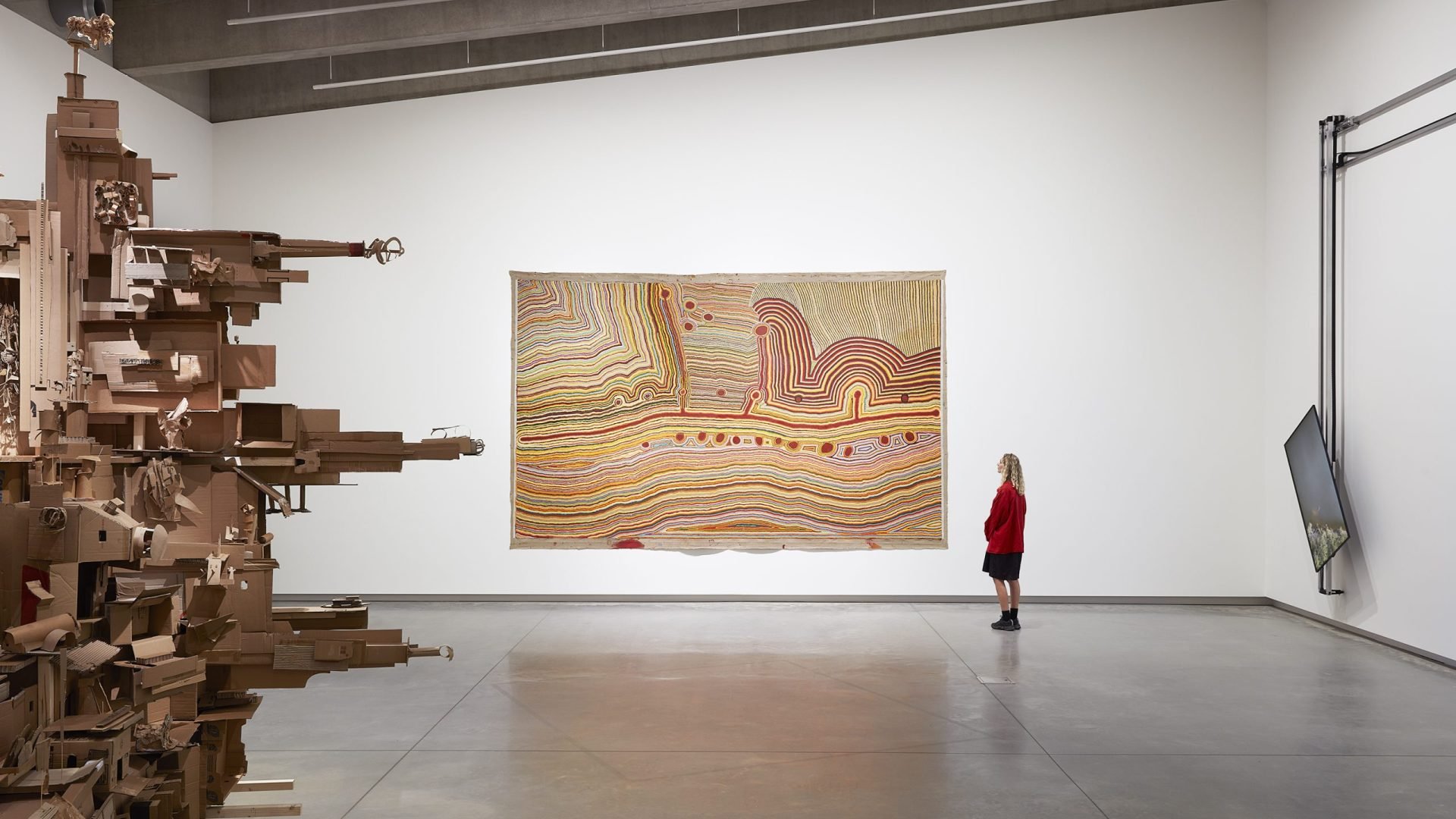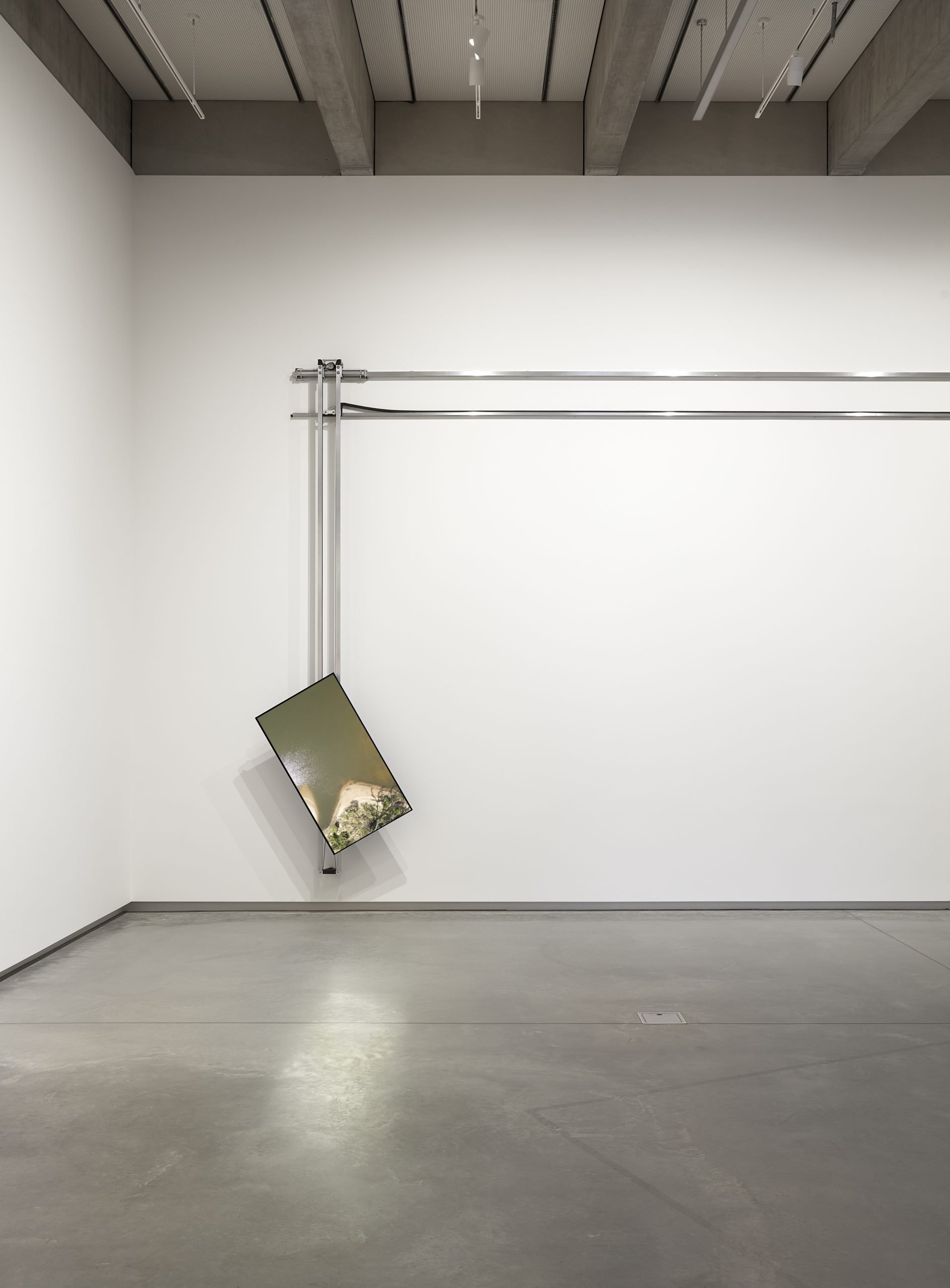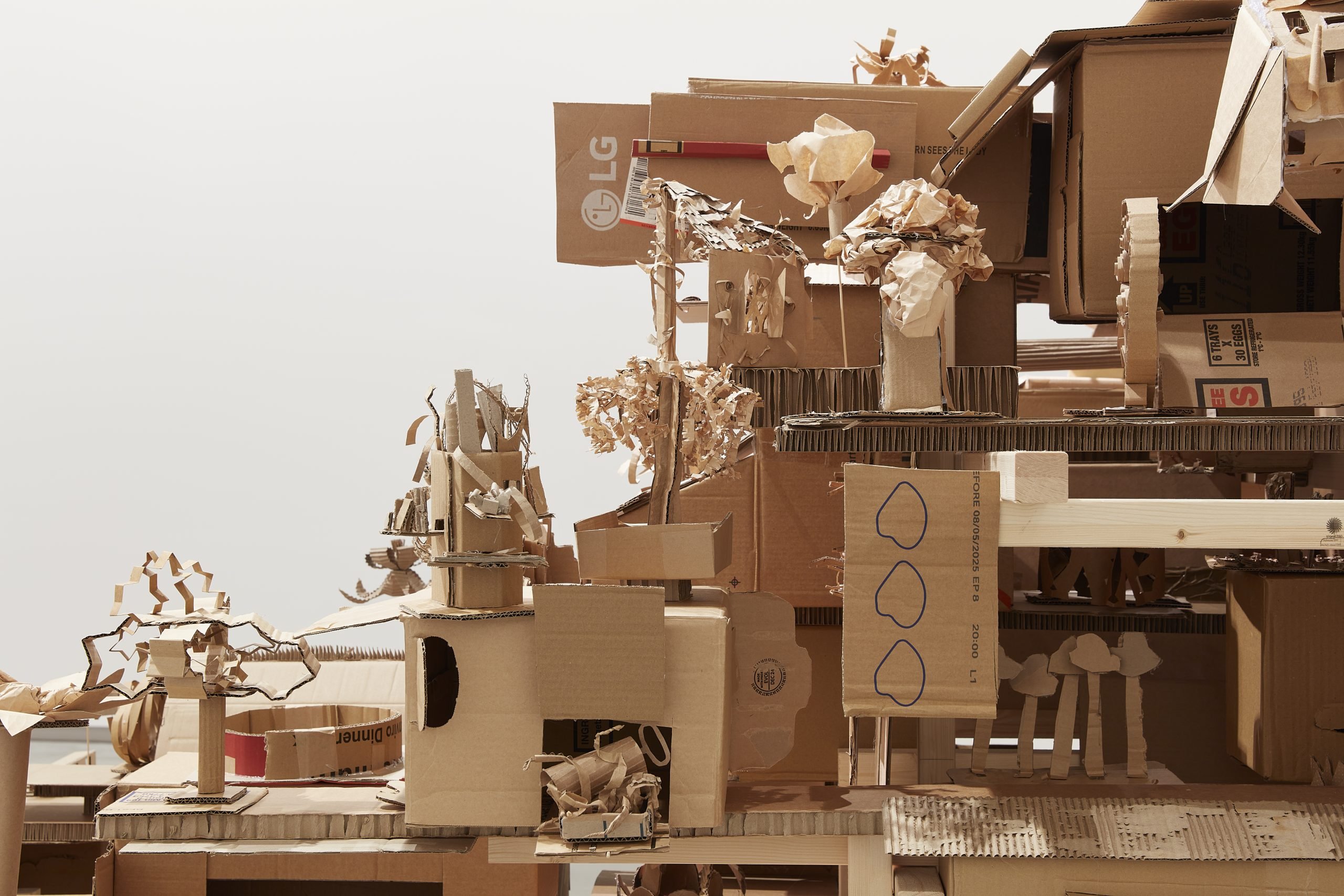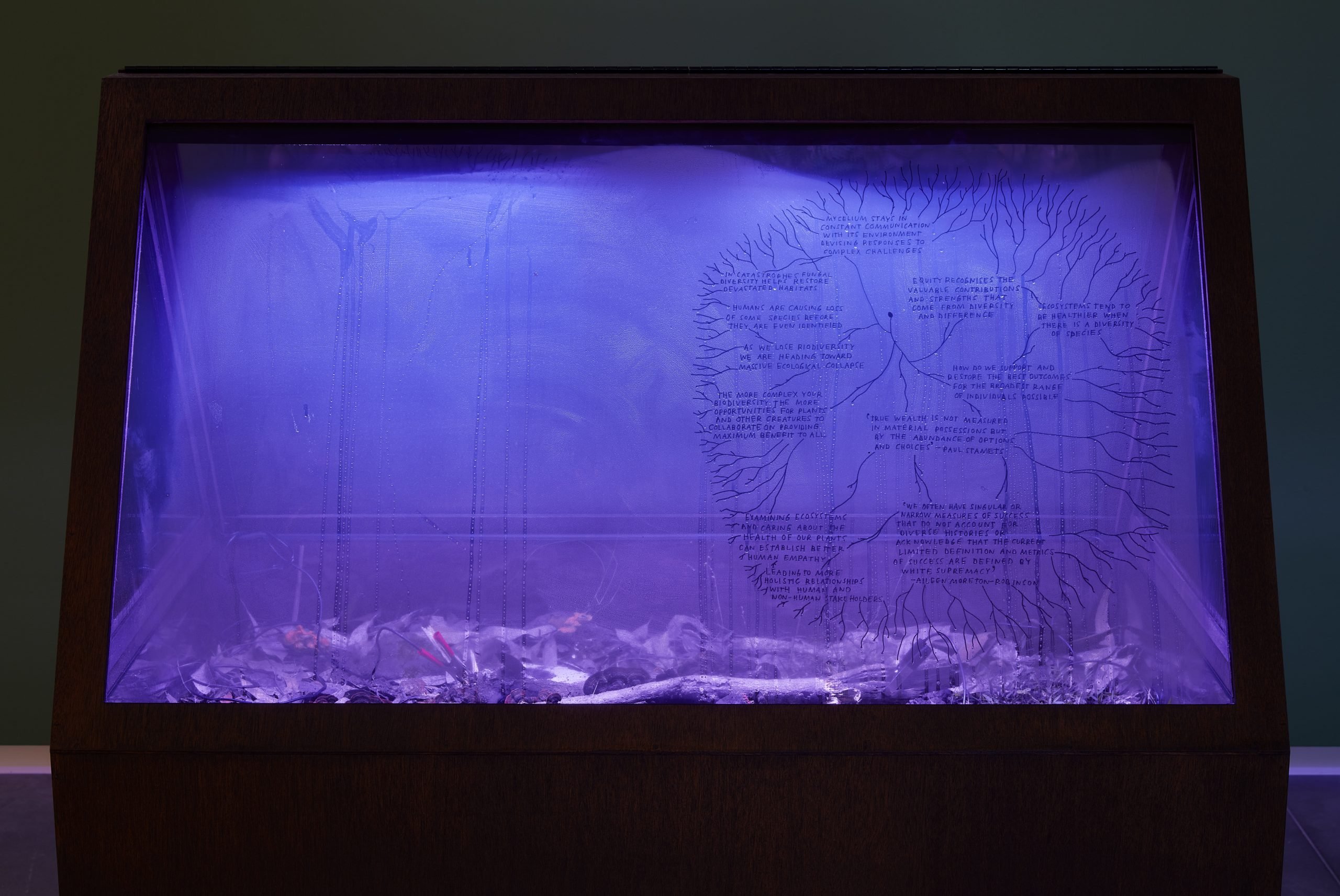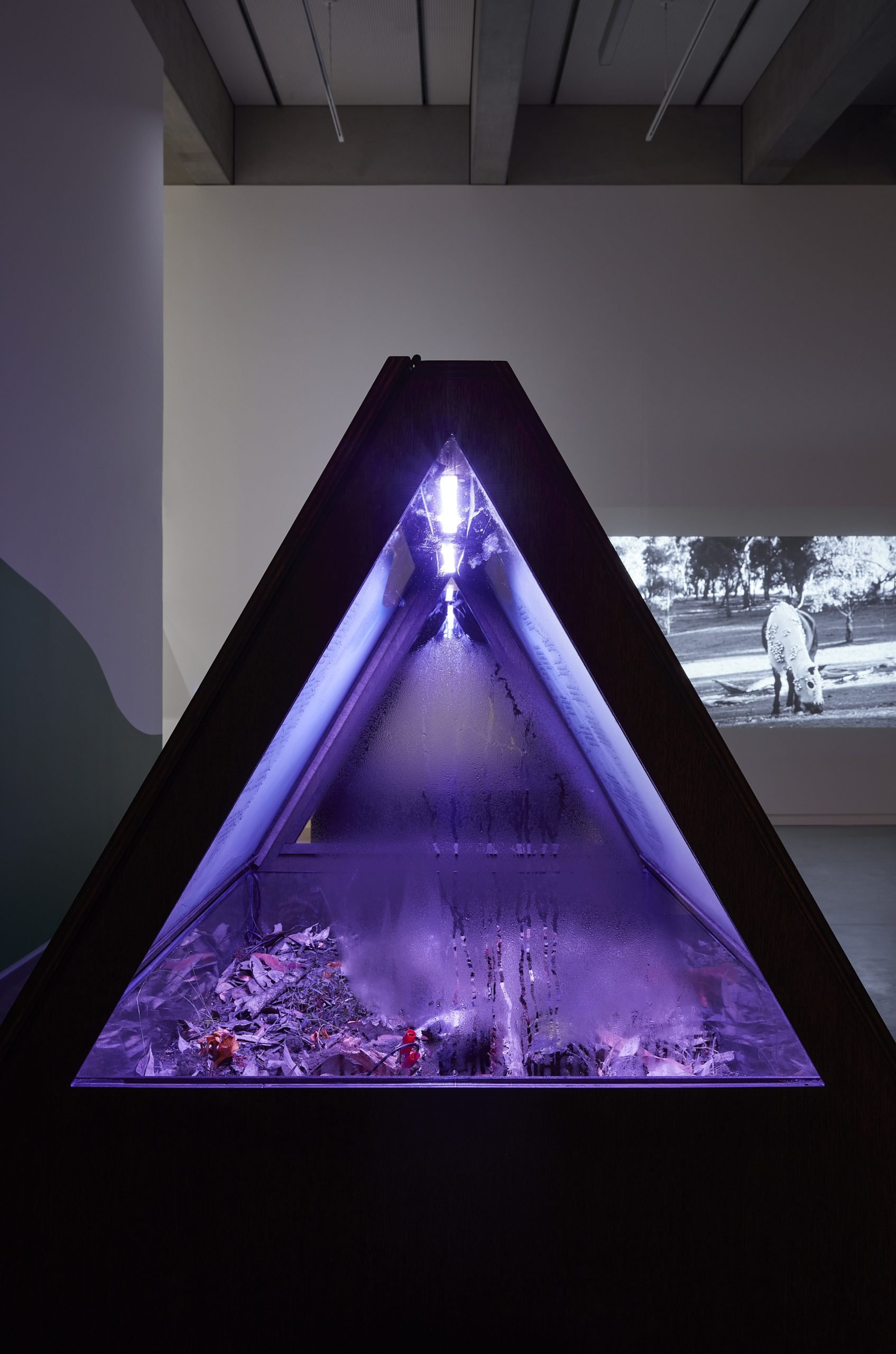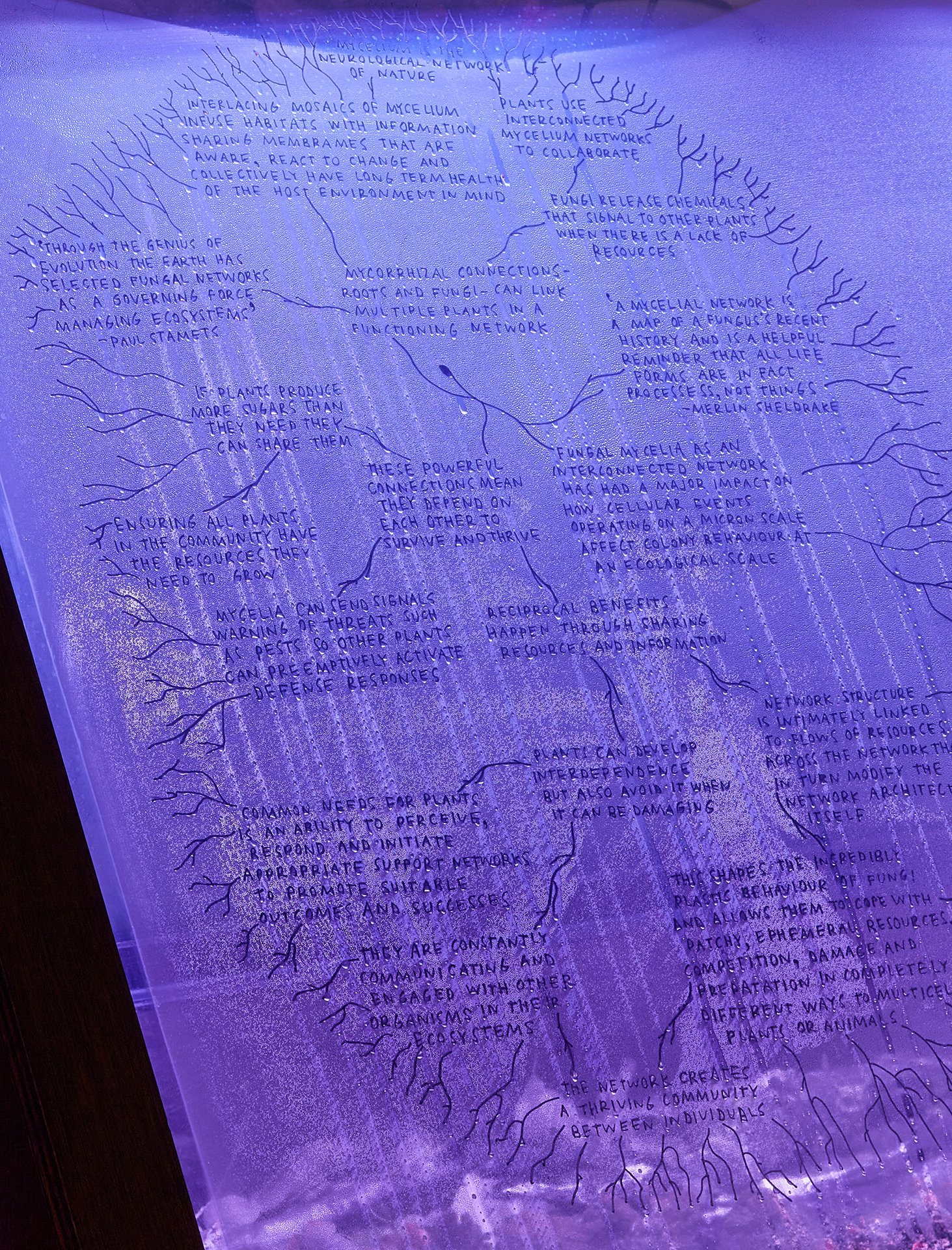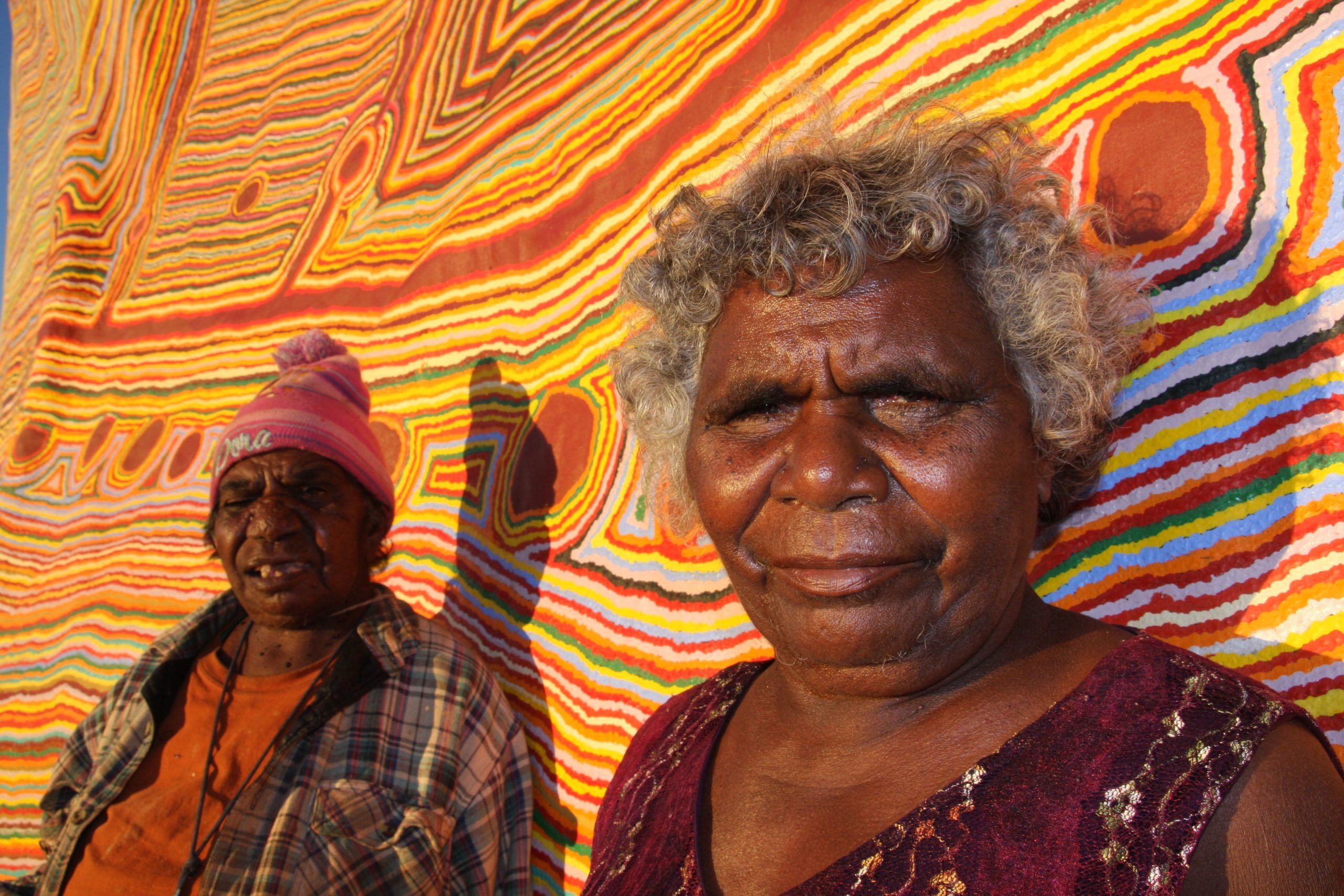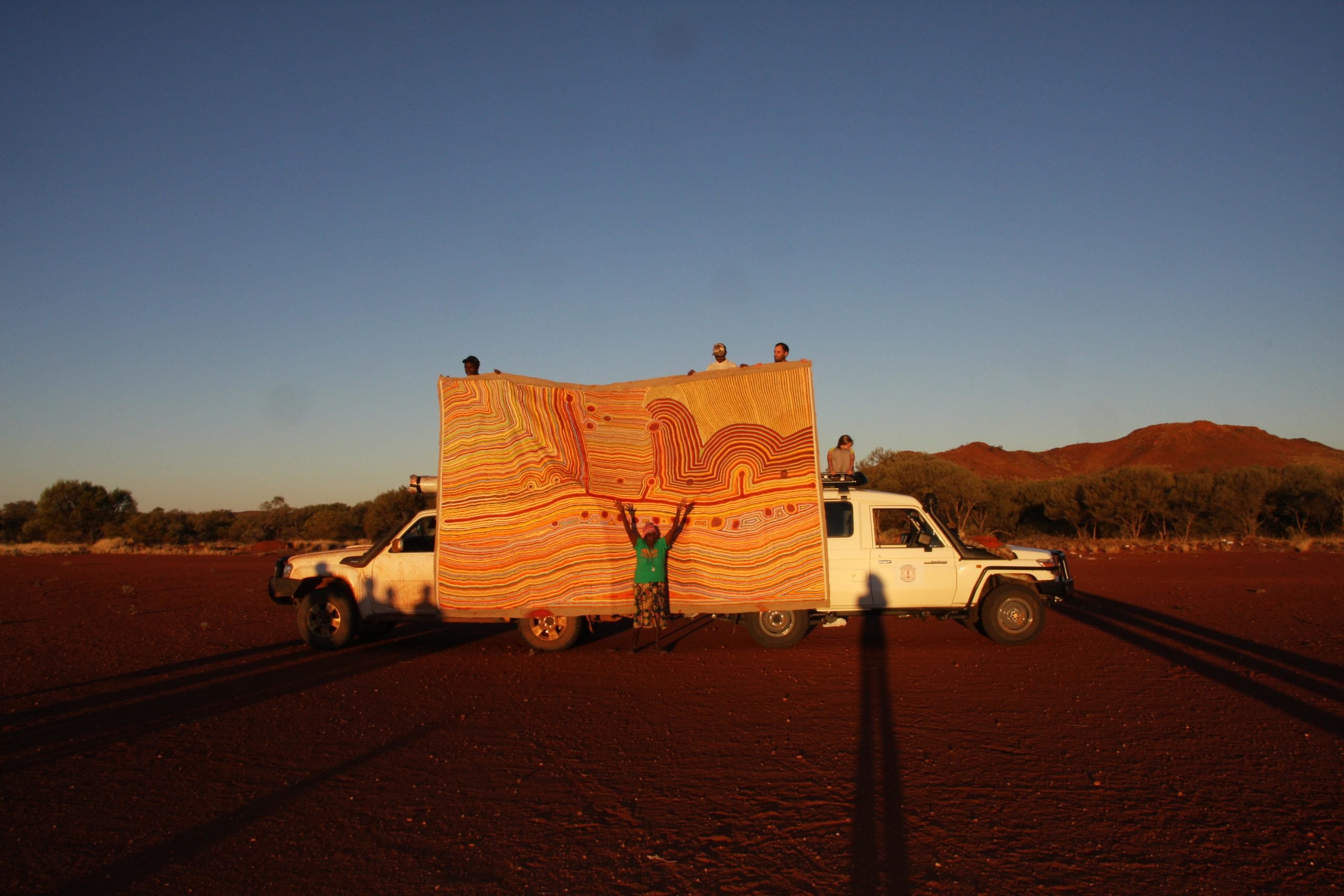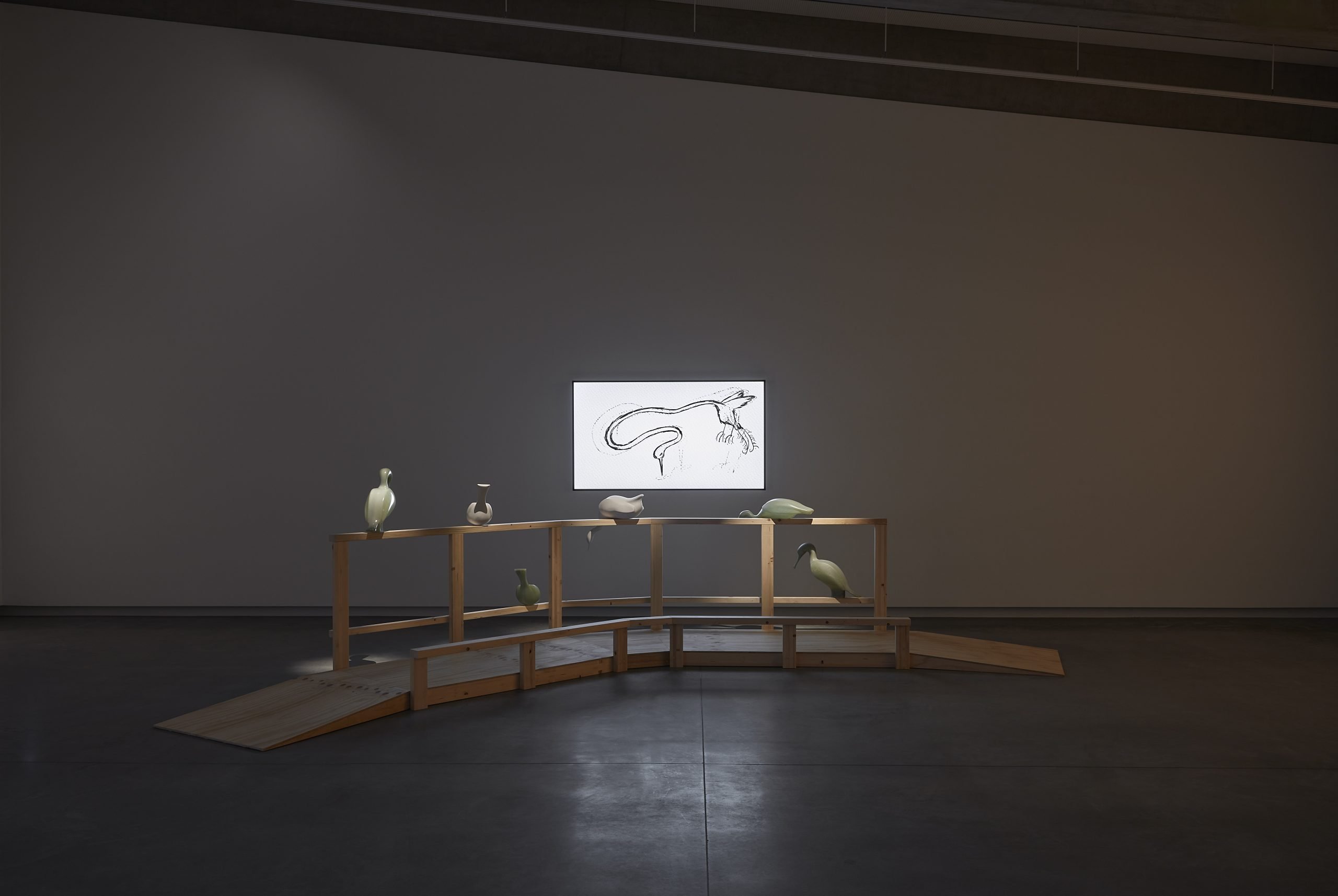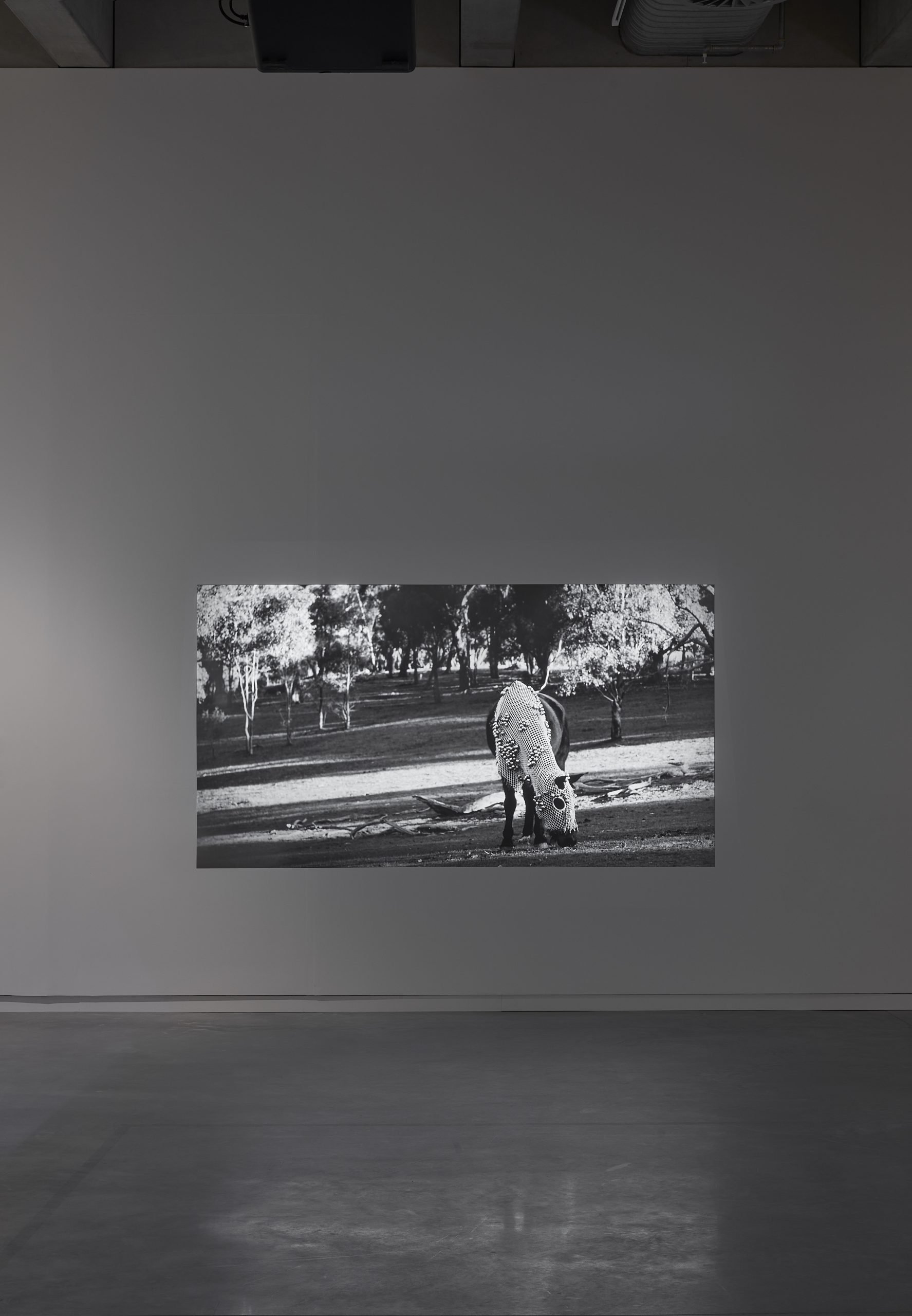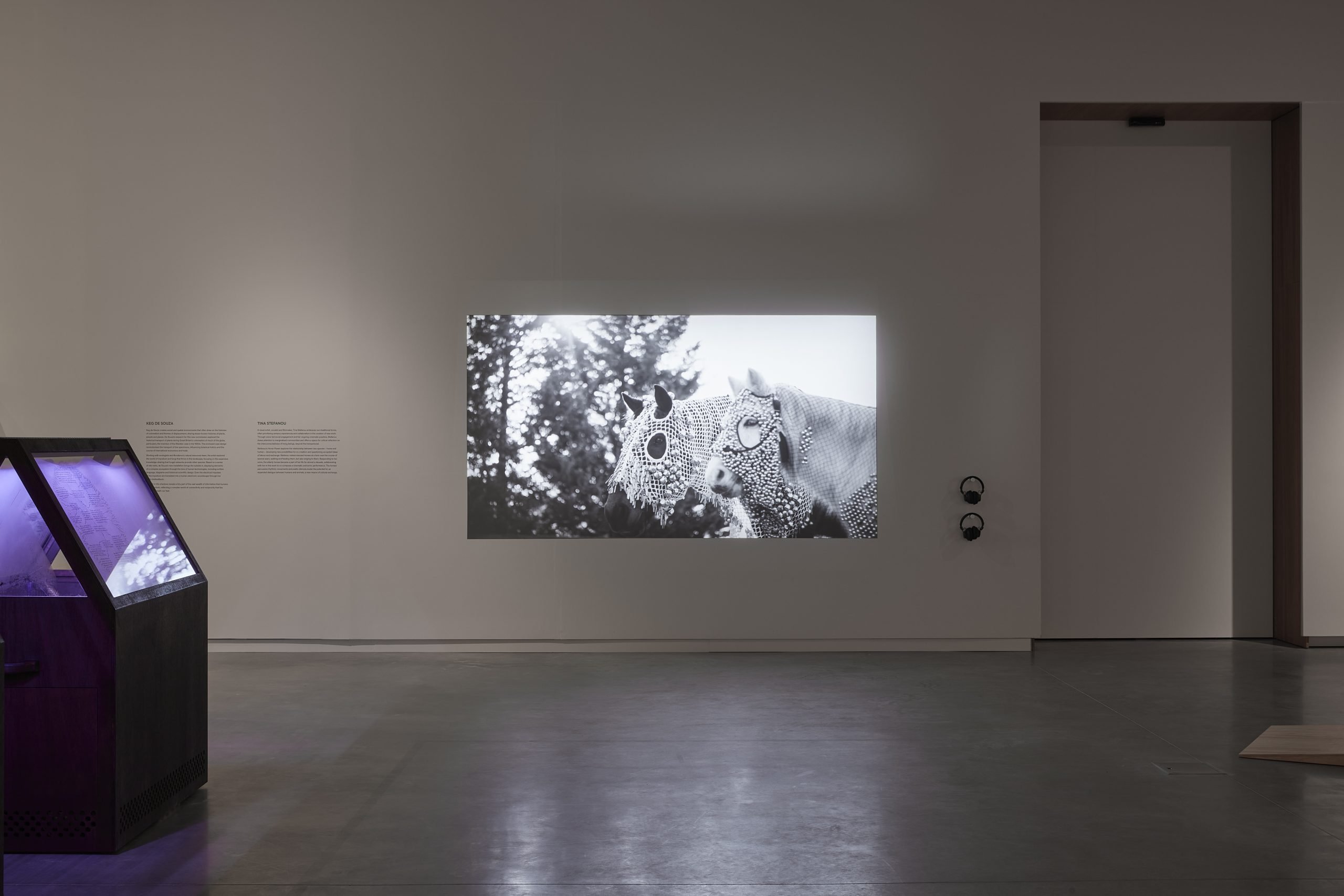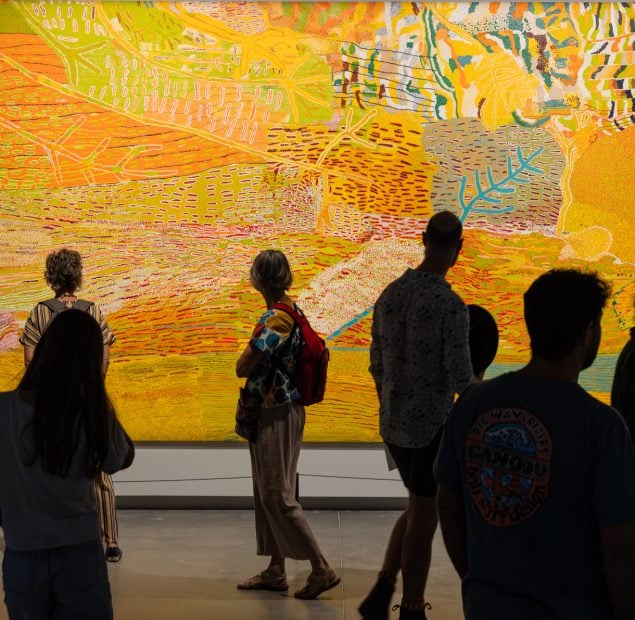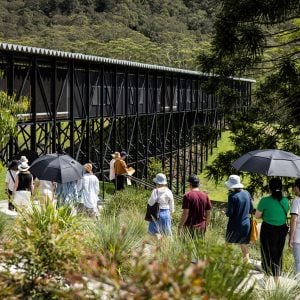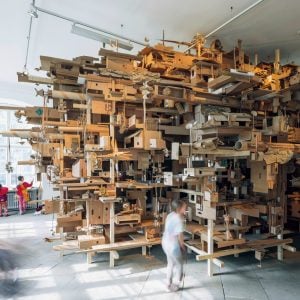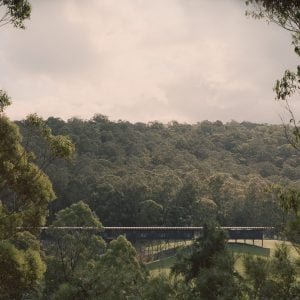1 March – 8 June 2025
Thinking together: Exchanges with the natural world presents major new commissions by contemporary artists Robert Andrew, Alfredo and Isabel Aquilizan and Keg de Souza, alongside paintings by the Martu communities of central Western Australia, and video works by Sorawit Songsataya and Tina Stefanou.
The exhibition explores themes of reciprocity and collaboration between the human and non-human. Each work responds to notions of community, and considers the possibility that new knowledge can only be created through a process of thinking together, via communal making, cooperation between the species and embodying First Nations practices of knowledge sharing. A central pillar of this approach is presented in the large scale collaborative paintings of the Martu communities of central Western Australia, reflecting long histories of creating together that strengthens culture and grounds knowledge in place. These works reflect a complex web of relationships, linking environmental and ritual knowledge, geographic information and ancestral stories, whilst also building strong connections between the artists who come together to paint.
Artists
Robert Andrew
new eyes — old Country is a meditative work that captures the contours and pathways of Bangli / the Shoalhaven River. Using drone footage captured whilst in residence at Bundanon, Robert Andrew translates the course of the river into a cumulative wall drawing made from materials sourced from the Bundanon landscape. Slowly building over time, this durational drawing will gradually gain intensity, reflecting the incremental ways in which knowledge of Country is gathered and understood.
Robert Andrew, a descendant of the Yawuru people, creates kinetic installations that bring together programmable machinery with natural materials found on Country. Working site-specifically, these complex installations explore the spiritual, cultural, and historical connections between land, waters, sky, and living things. The artist describes this work as an act of storytelling without words, reclaiming culture that has been hidden or lost through translation.
Alfredo and Isabel Aquilizan
Isabel and Alfredo Aquilizan create works that explore co-creation, social change and the collective spirit. REFLECTIONS/HABITATIONS, was inspired by the Aquilizan’s site visits to Bundanon and the landscape paintings of Arthur Boyd, and aligns with the Boyds’ vision for environmental preservation and regeneration. This expansive commission offers a space for visitors to reflect on their own relationship to the natural environment, while sparking an opportunity for collective imagining.
Cardboard serves as a key creative tool for the Aquilizans, a versatile and globally available material borrowed from everyday life that invites public participation and inclusive engagement. At Bundanon, exploring themes of home, regeneration, and human overdevelopment, the artists have built a major accumulative sculpture and drawing installation exploring the tree as a symbol of habitat and community.
Keg de Souza
Growth in the shadows reveals a tiny part of the vast wealth of information that humans often overlook, reflecting a complex world of connectivity and reciprocity that lies directly beneath our feet.
Working with ecologists and Bundanon’s natural resources team, the artist explored the world of mycelium and fungi that thrive in this landscape, focusing on the expansive knowledge-sharing that fungal networks provide other species. Based on a series of site visits, de Souza’s new installation brings the outside in, displaying elements of a complex ecosystem through the lens of human technologies, including written language, diagrams and historical scientific design. Even the electrical impulses of the mycelium are translated into a human electronic soundscape through live audio biofeedback.
Keg de Souza creates social and spatial environments that often draw on the histories of colonialism and themes of displacement, sharing lesser-known histories of plants, people and places. De Souza’s research for this new commission explored the historical transport of plants during Great Britain’s colonisation of much of the globe, particularly the invention of the Wardian case in the 1830s. This enclosed case design revolutionised the transport of live specimens, influencing botanical history and the course of international economics and trade.
The Martu Artists
Martumili Ngurra (This is all Martu’s Home) presents the Martu peoples’ homelands, including the Great Sandy and Gibson Deserts. The six artists who collaborated on the work all live or have strong family associations with the remote community of Parnngurr, located 370 kms east of Newman in Western Australia. The painting includes sacred sites, waterholes, and pathways that are integral to Martu life, whilst also recording the impacts of mining and modern pastoralism.
Artists from the Martu communities in Western Australia are renowned for their collaborative works, reflecting their deep knowledge of the land and ancestral stories. These impressive paintings serve an important role in the education of younger generations, ensuring culture is preserved. They depict the desert landscape in intricate detail, mapping significant cultural, social, and ecological sites, as well as sharing geographic information and instructions on caring for Country. These works are the result of collective processes where older and younger artists come together to paint, share stories and sing, passing down Martu knowledge to future generations.
Kalyu was painted as a protest against uranium mining exploration near Karlamilyi National Park in Western Australia. It depicts a fragile ecosystem with vital underground water systems, illustrating the interdependence of each of the elements and reflecting a deep cultural and ecological connection to Country. Kalyu is a powerful statement for the preservation of the desert environment. The painting documents the landscape from below the ground up to the surface of the earth.
[We] painted to save it from the uranium mine…and to tell them there is an underground stream…There’s no water on the surface to keep the dust down. That’s why we painted this big painting, to tell them and to teach others about the water system in our land. —Ngalangka Nola Taylor, 2014
Sorawit Songsataya
Thai-born New Zealand artist Sorawit Songsataya explores dynamic interrelations within the natural world, and draws on cross-cultural beliefs from both Thailand and Aotearoa New Zealand.
In Comfort Zone, Songsataya focuses on the kōtuku (Eastern great egret), an endangered species. Known as a tropical bird, the kōtuku is a familiar sight in Thailand’s rice fields but is at the limit of its geographic and climatic range when living and breeding in Aotearoa, where it is rarely seen. The phrase ‘he kōtuku rerenga tahi’ in Te Reo Māori means ‘a kōtuku of a single flight’ and is used in the context of a rare event or an honoured guest that seldom visits. Through a merging of live footage, 3D animation, voice and sculpture, Comfort Zone connects the human, non-human and celestial worlds. Songsataya juxtaposes microscopic images of the kōtuku’s feathers with animations of the birds soaring through the night sky, bridging the distances between the oral, physical, and metaphysical. A voiceover challenges the format of a traditional nature documentary, posing open-ended questions that probe our sense of belonging and connection to the natural world.
Tina Stefanou
Tina Stefanou’s Horse Power explores the relationship between two species – horse and human – developing new possibilities for co-creation and questioning accepted ideas of labour and exchange. Stefanou visited rescued horses at a farm over the course of several years, walking and feeding them, but also singing to them. Responding to her voice, the elderly horses became a part of her life for almost a decade, collaborating with her in this work to co-compose a cinematic and sonic performance. The horses’ percussive rhythmic movements and poetic silences evoke the potential for an expanded dialogue between humans and animals, a new means of cultural exchange.
A visual artist, vocalist and filmmaker, Tina Stefanou embraces non-traditional forms, often prioritising sensory experiences and collaboration in the creation of new work. Through voice-led social engagement and her ongoing cinematic practice, Stefanou draws attention to marginalised communities and offers a space for critical reflection on the interconnectedness of living beings, beyond the transactional.
ACCESS
Thinking together: Exchanges with the natural world is an accessible exhibition with several resources available below and at the Art Museum Reception. Visitors are advised that this season is an 80% visual exhibition, predominantly featuring sculpture, painting, film and soundscapes.
SENSORY MAP
The sensory map for Thinking together: Exchanges with the natural world includes information specifically on the Art Museum and current exhibition, noise and lighting levels and other information relevant to sensory processing. Please contact the museum staff if you have any questions about the exhibition or Bundanon Relaxed dates for sensory-friendly visits to the exhibition.
Phone: 02 4422 2101
TACTILE MATERIALS
This exhibition includes a drop-in Creative Play workshop, supported by Bundanon museum staff. The workshop operates throughout the day during museum opening hours in Gallery 4.
Creative Play is a free interactive experience designed by the internationally renowned artist duo, Alfredo and Isabel Aquilizan. Become part of the creative process as you dream, build, and contribute to this evolving collaborative sculpture inside the Art Museum.
Whether you’re a seasoned artist or just love to experiment, this is your chance to play and shape something unique. Your creation will form part of an evolving collaborative sculpture inside the Art Museum. Bring your ideas, roll up your sleeves, and leave your mark on this exciting and ever-growing installation.
Creative Play is an accessible program, please get in touch with our friendly museum staff if you have any questions.
Phone: 02 4422 2101
SEATING
There is a small amount of seating in the exhibition. Individual seating is available from museum reception, please speak with the friendly staff if you would like extra seating to experience the show.
There is also a wheelchair available to borrow from the museum reception.
LARGE PRINT
Large print versions of the exhibition roomsheet are available to borrow from museum reception.
Audio Descriptions
A selection of audio descriptions are available below for rooms and works in the exhibition. For support in accessing the descriptions below, please speak to the gallery reception staff.
Audio descriptions are listed by room, clockwise.
Gallery One
Martu Artists, Martumili Ngurra (This is all Martu’s Home), 2009.
Robert Andrew, new eyes – old Country, 2025.
Isabel & Alfredo Aquilizan, REFLECTIONS / HABITATIONS, 2025.

